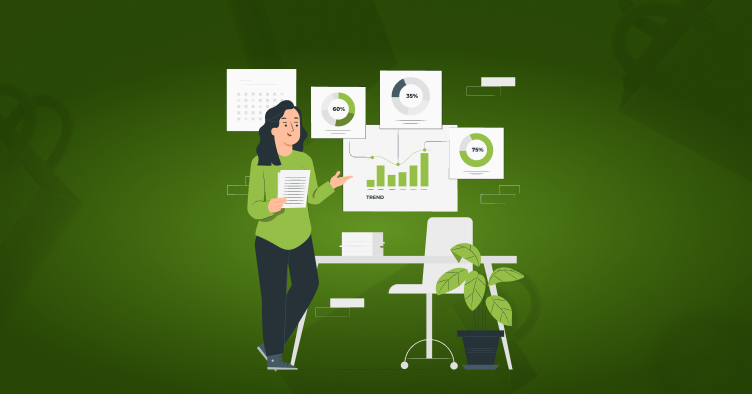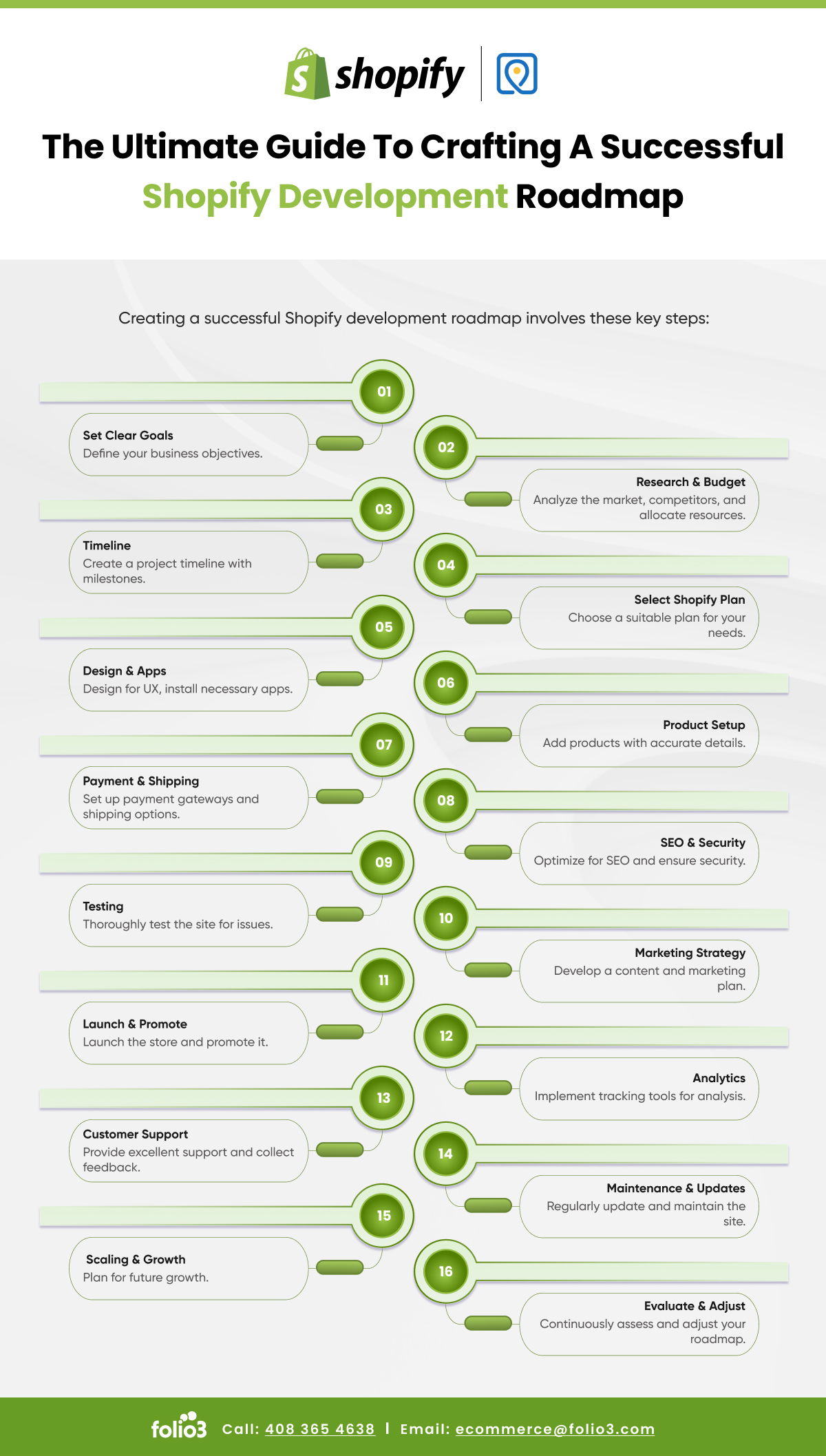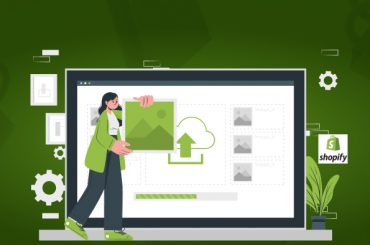Shopify Development Roadmap: Key Milestones and Best Practices
Last Updated | January 8, 2024
Table of Contents
In today’s fast-paced e-commerce landscape, having a well-defined roadmap is crucial for success.
Whether you are a seasoned developer or just starting out, understanding the key milestones and best practices in the Shopify development process can greatly enhance your ability to build exceptional e-commerce experiences.
In this blog, we will explore the key milestones and best practices that will help you unlock the full potential of Shopify. From setting up your development environment to mastering the art of creating stunning themes and powerful apps, we have got you covered with this guide on the Shopify development roadmap.
- According to ReConvert, only 10% of Shopify stores are successful.
- Demand Sage suggests that the US has the most number of Shopify stores, which is 13,847.
- The Social Shepherd states that 87% of merchants use Shopify apps in their stores.
| Step | Description |
|---|---|
| 1. Define Your Goals and Objectives | Clearly define your business objectives and what you want to achieve with your Shopify store. |
| 2. Research and Market Analysis | Conduct thorough market research to understand your target audience, competitors, and trends. |
| 3. Choose the Right Shopify Plan | Select the most suitable Shopify plan based on your needs, features, scalability, and budget. |
| 4. Website Design and User Experience | Invest in responsive, user-friendly design and streamline the user experience for customers. |
| 5. Product Catalog and Inventory Management | Create detailed product listings and implement inventory management for stock tracking. |
| 6. SEO and Content Strategy | Develop an SEO strategy and content plan to improve search rankings and engage your audience. |
| 7. Marketing and Promotion | Plan marketing efforts, including email, social media, PPC, and leverage Shopify apps. |
| 8. Payment and Shipping Options | Set up secure payment gateways and provide multiple shipping options with clear policies. |
| 9. Security and Compliance | Ensure store security, use SSL certificates, and comply with data protection regulations. |
| 10. Analytics and Performance Monitoring | Implement analytics tools to track KPIs and regularly review data for informed decisions. |
| 11. Customer Support and Engagement | Offer excellent customer support through various channels and engage with customers. |
| 12. Scalability and Future Development | Plan for growth by choosing scalable apps and continuously updating your store. |
| 13. Testing and Quality Assurance | Test your website thoroughly before launch and perform regular quality assurance checks. |
| 14. Budget and Timeline | Create a budget and timeline, allocating resources and accounting for dependencies. |
| 15. Continuous Improvement | Monitor store performance, gather feedback, and adapt the roadmap to evolving needs and trends. |
Roadmap To Shopify Development
In this section, we are going to focus mainly on the factors involved in the Shopify development roadmap. We will list these factors number-wise so that you can understand the chronology of each factor within this roadmap.
1. Define Your Goals
As stated in Shopify development guidelines, you should always start by clearly defining your goals and objectives for your Shopify web development project. Determine what you want to achieve with your online store, such as increasing sales, expanding your customer base, or improving brand visibility.
2. Research And Plan
Conduct thorough market research to understand your target audience, competitors, and industry trends. Use this information to create a comprehensive plan that outlines your store’s structure, design, and functionality. Consider factors like product categories, payment gateways, shipping options, and marketing strategies to strengthen your Shopify development direction.
3. Set Up Your Shopify Store
This is the most important part of the Shopify development map. You have to sign up for a Shopify account and choose a suitable pricing plan. Customize your store’s settings, including the domain name, currency, and language. Configure essential features like taxes, shipping, and payment gateways. Familiarize yourself with the Shopify admin interface and navigation.
4. Select a Theme
This is a Shopify development standard procedure. So, browse through Shopify’s extensive theme library and choose a visually appealing and responsive theme that aligns with your brand identity. Customize the article to reflect your unique style and optimize it for mobile devices. Ensure that the theme is user-friendly and provides a smooth browsing experience.
5. Customize Your Design
Use Shopify’s built-in theme editor or hire a Shopify developer to customize the design of your store. Modify colors, fonts, and layouts to match your brand.
You can also use Shopify development instructions to create a visually appealing and intuitive user interface that enhances the overall user experience.
6. Add Products and Collections
Organize your products into logical categories and collections. Upload high-quality product images and write compelling descriptions. Set up pricing, inventory management, and product variants if applicable. Implement product search and filtering options to help customers find what they’re looking for easily.
7. Enhance Functionality with Apps
Explore the Shopify App Store to find apps that can enhance your store’s functionality. Install and configure apps for features like social media integration, email marketing, customer reviews, and analytics.
Be mindful of app compatibility and performance to ensure a smooth user experience. This Shopify development approach can affect the speed and optimization of your store.
8. Optimize For SEO
Implementing SEO strategies is one of the best Shopify development tactics to improve your store’s visibility in search engine results.
Optimize meta tags, URLs, and headings with relevant keywords. Create unique and engaging content that includes product descriptions, blog posts, and landing pages. Leverage Shopify’s built-in SEO features and consider using SEO apps for additional optimization.
9. Test And Refine
In order for your Shopify development machination to be successful. You have to thoroughly test your Shopify store across different devices, browsers, and operating systems. Check for any broken links, design inconsistencies, or performance issues. Gather feedback from users and make necessary improvements to enhance usability and functionality.
10. Launch and Promote
Once you’re satisfied with your store’s design and functionality, it’s time to launch it to the public. Develop a marketing strategy to promote your store through various channels, such as social media, email marketing, content marketing, and paid advertising. Monitor your store’s performance using analytics tools and make data-driven decisions to optimize conversions and sales.
11. Maintain And Update
Regularly update your store with new products, promotions, and content to keep it fresh and engaging. Stay informed about Shopify’s updates and new features, and implement them to enhance your store’s performance.
Monitor customer feedback, address any issues promptly, and continuously improve the user experience.
By following this roadmap, you’ll be able to navigate the Shopify web development process effectively and create a successful online store that drives sales and delights customers.
Best Development Practices
When it comes to the Shopify development roadmap, following best practices is crucial to ensure a seamless and successful Shopify development system.
Read Also Shopify Development Plan
These practices enhance the performance and functionality of your Shopify development workflow and also contribute to a positive user experience. Following are some key best practices to keep in mind:
Customize With Care
While it’s tempting to customize every aspect of your Shopify store, it’s important to strike a balance. Let’s say you want to add a custom feature that allows customers to personalize their products with custom text.
Instead of building a complex and resource-intensive solution from scratch, consider using a reliable app from the Shopify App Store that specializes in product personalization.
This approach saves development time, ensures compatibility with future updates, and provides a seamless user experience. You can also hire a Shopify development Company to do it for you.
Optimize For Mobile
With the majority of online traffic coming from mobile devices, it’s essential to prioritize mobile optimization. Ensure that your Shopify store is responsive and provides a seamless browsing experience across various screen sizes.
Read Also Building a Shopify App
Test your store on different devices to identify and fix any issues. Therefore, we suggest you opt to hire Shopify expert to make your site mobile responsive.
Use a Version Control System
Implementing a version control system, such as Git, is crucial for managing code changes and collaborating with other developers.
It allows you to track modifications, revert to previous versions if needed, and work on different features simultaneously without conflicts. This can also be highly useful for Shopify app development.
Implement Structured Data
Structured data is like a language that search engines understand, allowing them to better interpret and display your store’s content in search results.
This is the most important part of Shopify website design. Let’s say you’re selling organic skincare products and want search engines to display rich snippets with product ratings, prices, and availability.
Read Also How To Make A Shopify App
By implementing Schema.org markup on your product pages, you provide search engines with the necessary information to enhance your store’s visibility and potentially attract more clicks from interested customers.
We understand this can be difficult to understand, so contact any Shopify store development company if you think it is a little complex,
Keep Your Code Organized
Writing clean and organized code is essential for maintainability and collaboration. For example, when developing a custom Shopify theme, follow coding standards, use proper indentation, and break your code into modular components.
Organizing your codebase makes it easier for other developers to understand and contribute to your project. Additionally, clean code reduces the chances of introducing bugs and makes it simpler to troubleshoot and update your store in the future.
Optimize Page Load Speed
Just like the custom Shopify app, your custom website can also be a victim of slow-loading pages that lead to high bounce rates and poor user experience.
Hence, optimize your Shopify store’s performance by minimizing image sizes, leveraging caching techniques, and optimizing code. Regularly monitor and analyze your store’s speed using tools like Google PageSpeed Insights or GTmetrix for optimal Shopify speed optimization.
Secure Your Store
Protecting your customers’ data is of utmost importance. Ensure that your Shopify store is using a secure HTTPS connection and implement additional security measures such as two-factor authentication and regular backups.
Stay updated with the latest security patches and monitor for any suspicious activities. You can either hire Shopify developer or a Shopify plus agency to take care of security.
Stay Updated With Shopify’s Ecosystem
Shopify regularly releases updates, new features, and improvements to its platform. Stay informed about these updates and advantage of new functionalities to enhance your store’s performance and stay ahead of the competition.
By following these best practices, you will be well-equipped to create a high-performing and user-friendly Shopify store that not only meets but also exceeds your customers’ expectations.
Conclusion -Shopify Development Roadmap
In conclusion, whether you are a business owner looking to establish a powerful online presence or a developer seeking to expand your skill set, this Shopify Development Roadmap will equip you with the knowledge and tools necessary to tackle the challenges of e-commerce development head-on.
By following the recommended milestones and incorporating the best practices outlined in this guide, you will be well-equipped to build high-performing, visually captivating, and conversion-focused Shopify stores that leave a lasting impact on your audience.
Shopify Development Roadmap: Frequently Asked Questions
1. What is the Shopify Development Roadmap?
The Shopify Development Roadmap is a planned outline detailing all the planned updates, features, and improvements intended for Shopify’s platform over a given period. This roadmap helps developers understand what to expect in the future and plan their projects accordingly.
2. Where can I find the Shopify Development Roadmap?
The roadmap can usually be found on Shopify’s official website, specifically in their developer’s section. Shopify may also share updates through their blog or developer newsletters.
3. How often is the Shopify Development Roadmap updated?
Shopify frequently updates its roadmap, but the frequency can vary depending on many factors, such as user feedback, technological advancements, or business needs. It’s recommended to regularly check the official website or subscribe to Shopify’s newsletters for the latest updates.
4. Are there different roadmaps for different aspects of Shopify, like UX/UI, backend development, API development, etc?
While the primary Shopify Development Roadmap outlines general features and improvements for the entire platform, there might be separate, more detailed roadmaps for specific aspects like UX/UI, backend development, and API development. The availability of these would be communicated through Shopify’s official channels.
5. How reliable is the Shopify Development Roadmap?
Shopify is committed to providing accurate and timely information on their development roadmap. However, like any tech company, changes can happen due to unforeseen circumstances. These can include technology shifts, user feedback, or changing business needs. It’s always recommended to keep this in mind and stay updated on the latest changes.
6. Can I provide feedback on the Shopify Development Roadmap?
Absolutely. Shopify encourages feedback from developers and merchants. You can usually provide feedback through Shopify’s developer forums or other designated channels.
7. Does the Shopify Development Roadmap include estimated release dates?
The roadmap typically includes estimated timelines for new features and updates, but these are subject to change. Shopify works hard to stick to these timelines, but unforeseen issues may cause delays. It’s advisable to check regularly for updates on release dates.
8. Is the Shopify Development Roadmap the same for all regions?
While the core updates and features outlined in the roadmap are the same worldwide, some features might roll out regionally due to local regulations, language support, or other considerations.
9. What should I do if I encounter a problem with a new feature outlined in the Shopify Development Roadmap?
If you encounter any issues with new features, it’s recommended to reach out to Shopify’s developer support. They can help troubleshoot the issue and provide guidance on how to resolve it.
10. What if a feature I want isn’t on the Shopify Development Roadmap?
If there’s a feature you want that isn’t on the roadmap, it’s a good idea to share this feedback with Shopify. They continually review feedback from developers and merchants to inform their future updates and features.








